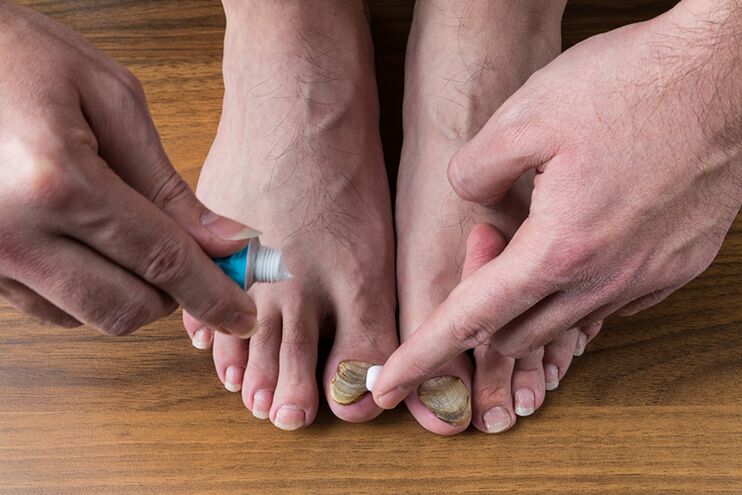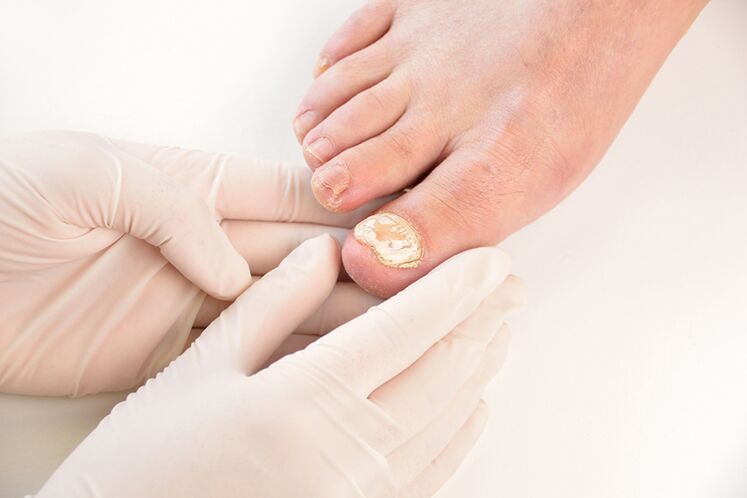
Nail fungus is one of the most common dermatological diseases. A fungal infection affects the nail plate, nail bed, and surrounding skin. Although the hands can also be affected by the infection, the fungal infection is most often found on the toes. An invisible pathogen is transmitted to feet through wet surfaces or through the air in bathrooms, saunas, swimming pools, gyms, and other places with high humidity.
Although nail fungus is statistically more common in older men with health problems, anyone can get it. Children often bring the disease from camps or sports clubs. Sometimes you can get infected at the home of relatives. To prevent serious complications, it is important to recognize the infection early and start treatment.
Types of toenail fungus
There are thousands of fungi that can parasitize a person or coexist peacefully with them. Only some of them cause onychomycosis or damage the nail plate.
If you are not sure what the change in nail structure is due to, make an appointment with a doctor. Based on external signs, the condition of the skin and the results of laboratory tests, a specialist will be able to determine the pathogen.

The destruction of the plaque begins when it becomes infected with one of the following fungi:
- dermatophytes. Common pests associated with chronic diseases of the skin, hair and nails. The pathological process develops against the background of weak immunity. If your immune defenses are in order, the infection will be limited to a brief and almost imperceptible desquamation. It can collect spores in a humid environment which contributes to the rapid reproduction of the fungus Trichophyton menagrophytes. This dermatophyte appears mainly on the thumbs. Already in the early stages, the skin around the fingers suffers. In a wet sauna or bathroom in your own home, you can also become infected with other dermatophytes. Trichophyton rubrum is first noticeable only at the end of the plate, but gradually captures the entire surface up to the root. The infection is accompanied by stratification.
- yeast mushrooms. Infect the skin of the hands or feet, rapidly develop protection against drug treatment. Fungi like Candida can remain on the skin or mucous membranes for years after infection. Signs of the disease appear only when your immune system is weakened, for example, in autumn or early spring. The focus of infection develops in the root. The nail quickly changes color, becomes dull. Without systemic treatment, the disease does not disappear, but rarely goes into the acute stage. With the strengthening of immunity, the lesion can temporarily disappear.
- Mold. For severe systemic lesions, moldy fungi are often responsible, of which scientists count more than 40 species. Mold organisms spread so actively that laboratory research does not always give unequivocal results about the nature of the disease. As a result, the fungus is either not diagnosed on time or treated for a long time with various drugs according to the brute-force method. If you do not find a drug for six months, there is a risk of developing serious complications.
signs
In the early stages of the infection, it is impossible to recognize the fungus on its own. The state of the nail plate will change only when the living cells of the fungus acquire a critical mass. The colonization of nails and skin is faster if you have weakened natural defenses:
- impaired health - weakened immunity due to insufficient or unbalanced nutrition, viral attacks or cold weather;
- the body does not have the resources to resist the disease;
- nutrition in the nail bed is disturbed.
In the absence of all these factors, the disease will still begin, but it will go unnoticed by you and others.
If the fungus managed to break through the body's defense systems and gain a foothold on the skin or nail plate, onychomycosis will gradually begin to develop. The affected areas will darken, air cavities will appear between the layers. If left untreated, the board will begin to delaminate.
Gradually, the entire surface of the nail can crack, become covered with a cloudy layer and turn black. You can remove a black nail with a special plaster or other means, but this will not protect you from relapses of the fungus. Although there was a slow darkening of the nail plate, the spores penetrated into the deeper layers of the skin. Without medical treatment, new nails will grow out already diseased, misshapen, or discolored.
There are several types of infection. They can be recognized by the main characteristics indicated in the table.
View |
Symptoms |
|---|---|
subungual form |
In the distal-lateral phase, skin irritation almost never occurs. Changes can only be determined by the appearance of the nail plate. An early symptom of onychomycosis is gray or yellow streaks at the end of the nail plate. If this part of the nail becomes brittle or flakes off, and the darkening returns even after cutting the infected part, you should see a doctor. A non-obvious sign is slow nail growth with good nutrition. |
white surface mold |
A small white spot appears on the nail, which does not cause discomfort. The skin is usually not scaly, red, or itchy. Cosmetic nail defects come and go without treatment. Other small defects are formed at the lesion site: small depressions in the plate, tuberosity. Symptoms of the disease often appear after a long stay in a humid environment. |
proximal subungual shape |
The first symptom is a thickening at the base of the nail fold. Since the affected areas are small, the first phase of the disease often goes unnoticed. The color of the hole changes, from transparent white to cloudy yellow, then white. Affected nails grow very slowly, but do not crack or peel. A few months after the color change of the well, the plaque begins to peel off rapidly. |
Total destruction (an advanced form of a fungal disease of any kind). |
The color of the plate changes significantly, the nails turn yellow. The nail looks unpleasant, it collapses along its entire length. Behind the exfoliated tissues, the skin is visible in places where it is usually closed. The skin around the infected fingers becomes inflamed and red. Possible scabies and itching. |
How to treat toenail fungus
The earlier it is possible to recognize the disease, the easier it will be to cure onychomycosis. This disease does not appear in a day. You will be able to notice unpleasant signs on the skin and nail plate long before the destruction of the nail if you inspect your toes every time you take a shower. Are there signs of infection? Then you need to see a doctor as soon as possible.
- The dermatologist will conduct a laboratory examination of the material of the nail plate, assess the stage of the lesion, select medications. Depending on the type of infection, the doctor may prescribe a single or systemic treatment. In the latter case, you will need to continue taking courses of pills or smearing the skin with creams for another six months after recovery. This will ensure that there are no relapses.
- The cosmetologist can cover the affected plates with medical varnish, pick up a cream for inflamed skin or carry out nail removal. Cosmetic treatment does not eliminate the cause of the infection, but it makes conservative treatment more effective. Biomaterial damaged by a fungus is contagious. By removing the exfoliated tissues, the beautician removes the largest source of infection.
Many types of onychomycosis appear mildly, such as a white coating, brittleness, or slow nail growth. Local treatment is appropriate for this type of injury. The doctor will prescribe topical preparations (ointments, creams, gels) that will not transfer the components into the bloodstream. Such treatment does not have unpleasant consequences in the form of an allergic reaction on the skin or weakening of the body. The medicine acts on the focus of the infection, so recovery is faster.
Systemic treatment of mycosis is necessary in the following cases:
- large deformations appear along the entire length;
- cracks or folds appear;
- the process has spread to several nails, the skin of the fingers is contagious;
- damaged and infectious nail root;
- large black or yellow areas appear;
- the plate is stratified to the base;
- a fungus is found on the skin;
- quick fixes don't help.
Systemic therapy begins with diagnosis. It is important to quickly recognize the reasons for initiating targeted treatment. In addition to taking medications, you will need to take steps to improve your health. Your doctor may recommend that you stay home for the first week to prevent an acute infection.
For complex therapy, two types of drugs are selected:
- To relieve symptoms. Onychomycosis and other forms of athlete's foot often cause irritated and itchy skin. This deprives the already weakened body of strength.
- Drugs with cumulative effect. Funds of this type do not start acting immediately. The drug must enter the bloodstream through the skin or stomach and accumulate on the nail plate in sufficient quantities. After a few weeks, the fungus will die on its own.
effective antifungals
You can cure nail and skin fungus without leaving your home. But if you choose the wrong remedy, then under the right conditions, the infection will recapture your fingers. It should be treated only if you are sitting at home due to illness or cannot temporarily visit a dermatologist for other reasons. In this case, it is worth trying drugs that are suitable for home use:
- Cream for external use from the group of imidazoles. Treats onychomycosis, early forms of mycosis, and most fungal infections known to science. Suitable for the treatment of the nail plate and skin. One of the most popular first means - quickly kills fungal colonies, prevents relapses. It can be used at home without medical supervision - the drug has almost no contraindications.
- Antifungal agent for external use, belonging to the group of allylamines. Treats the consequences of onychomycosis and other forms of mycosis, is safe for the skin, suitable for the treatment of children and pregnant women. This is a fast-acting cream - complex forms of the disease are treated in a couple of weeks. If after a couple of months deformations or white plaque are formed again, the course should be repeated.
















